 W
WRomanesque art is the art of Europe from approximately 1000 AD to the rise of the Gothic style in the 12th century, or later depending on region. The preceding period is known as the Pre-Romanesque period. The term was invented by 19th-century art historians, especially for Romanesque architecture, which retained many basic features of Roman architectural style – most notably round-headed arches, but also barrel vaults, apses, and acanthus-leaf decoration – but had also developed many very different characteristics. In Southern France, Spain, and Italy there was an architectural continuity with the Late Antique, but the Romanesque style was the first style to spread across the whole of Catholic Europe, from Sicily to Scandinavia. Romanesque art was also greatly influenced by Byzantine art, especially in painting, and by the anti-classical energy of the decoration of the Insular art of the British Isles. From these elements was forged a highly innovative and coherent style.
 W
WOne of the first streams of Romanesque architecture in Europe from the 10th century and the beginning of 11th century is called First Romanesque or Lombard Romanesque. It took place in the region of Lombardy and spread into Catalonia and into the south of France. Its principal decoration for the exterior, bands of ornamental blind arches are called Lombard bands. It was characterized by thick walls and lack of sculpture in facades, and with interiors profusely painted with frescoes.
 W
WRomanesque architecture is an architectural style of medieval Europe characterized by semi-circular arches. There is no consensus for the beginning date of the Romanesque style, with proposals ranging from the 6th to the 11th century, this later date being the most commonly held. In the 12th century it developed into the Gothic style, marked by pointed arches. Examples of Romanesque architecture can be found across the continent, making it the first pan-European architectural style since Imperial Roman architecture. The Romanesque style in England is traditionally referred to as Norman architecture.
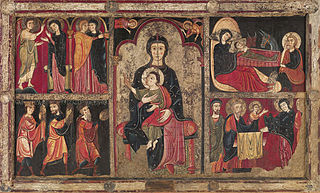 W
WThe Altar frontal from Avià is a rare Romanesque altar frontal exhibited at the National Art Museum of Catalonia in Barcelona. It is the front of the altar of the church of St. Mary of Avià, in the county of Berguedà, later moved to MNAC Barcelona, while the church has a replica in place. It is dated to the 13th century or earlier, and was painted by an unknown artist.
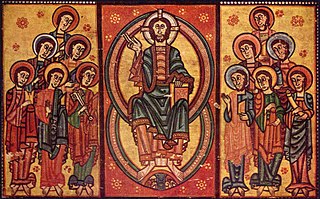 W
WThe Altar frontal from La Seu d'Urgell or of The Apostles is a Romanesque altar frontal currently exhibited at the National Art Museum of Catalonia. The work dates from the second quarter of the 12th century and comes from a church of the Bishop of La Seu d'Urgell and was acquired in 1905. It is one of the masterpieces of the collection of panel painting of the MNAC. The frontal, the item covering the front of the altar, stands out for the quality of its bright colours and because it illustrates some of the characteristics of composition in Romanesque art, such as bilateral symmetry, abstraction of the background, with no reference to space or context, and the unnatural geometrical treatment of form to be observed in the folds of the clothing. It also shows certain conventions of representation, such as so-called hierarchical perspective, which consists in representing the chief character in a larger size.
 W
WThe Altar frontal from Tavèrnoles is Romanesque altar frontal exhibited at the National Art Museum of Catalonia in Barcelona.
 W
WThe Apse of Sant Climent de Taüll is a Romanesque fresco in the National Art Museum of Catalonia, Barcelona. This is one of the masterpieces of the European Romanesque. from which the unknown Master of Taüll takes his name. Painted in the early 12th century, it was in the church of Sant Climent de Taüll at the Vall de Boí, Alta Ribagorça in the Catalan Pyrenees until removed in 1919-1923, along with other parts of the fresco decoration, in an attempt to preserve the paintings by placing them in a stable, secure museum setting.
 W
WThe Apse of Santa María d'Àneu is a romanesque apse of the church of Santa Maria, Àneu, the transferred frescos from which are now exhibited at Museu Nacional d'Art de Catalunya, in Barcelona. The decoration of the apse of the church of Santa María d’Àneu combines themes and motifs from the Old and New Testaments. Originally painted at the Church of Santa María d’Àneu
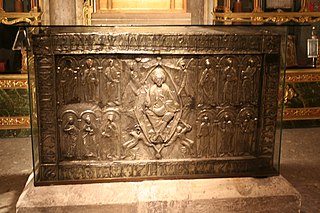 W
WThe Arca Santa is an oak reliquary covered with silver-gilt decorated in the Romanesque style. It is kept in the Cámara Santa of the Cathedral of San Salvador in Oviedo. In 1934 the Cámara Santa suffered an explosion that severely damaged the Arca, which was carefully restored by Manuel Gómez-Moreno.
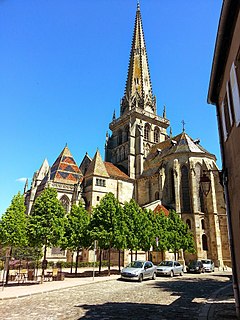 W
WThe Cathedral of Saint Lazarus of Autun, commonly known as Autun Cathedral, is a Roman Catholic cathedral in Autun and a national monument of France. Famous for its Cluniac inspiration and its Romanesque sculptures by Gislebertus it is a highlight in Romanesque art in Burgundy and it is the seat of the Bishop of Autun. The Bishop of Autun set forth the construction of St. Lazarus Cathedral as a result of the large movement of pilgrims travelling to Vezelay as they progressed on the pilgrimage route to Santiago de Compostela.
 W
WThe Azelin chandelier is a Romanesque wheel chandelier, made in the 11th century for the Hildesheim Cathedral in Hildesheim, Germany, a UNESCO World Cultural Heritage site since 1985. It is the oldest of four extant wheel chandeliers from that period, along with the Hezilo chandelier, also in Hildesheim, the Barbarossa chandelier in the Aachen Cathedral, and the Hartwig chandelier in the Abbey of Comburg. It was believed to be donated by Bishop Azelin, however his predecessor Thietmar is more likely to be the patron. Therefore, the chandelier is also called the Thietmar chandelier (Thietmarleuchter).
 W
WThe baldachin of Ribes is a fragmentary altar-canopy in the Romanesque style now in the Episcopal Museum of Vic. It is the masterpiece of the so-called "Ripoll workshop". It dates to the second quarter of the twelfth century. The surviving fragment is only one fourth the size of the original, which contained a central mandorla with the figure of Christ and four angels on each side.
 W
WThe Bronze baptismal font in the Hildesheim Cathedral is a late Romanesque baptismal font which was probably made in Hildesheim in the first third of the thirteenth century. It is noted for its pictorial decoration which is of the highest quality and for its perfect proportions and is considered among the most outstanding works of its type. For centuries the baptismal font stood in the western part of the nave, until it was moved to the last of the northern side-chapels in 1653. During the ongoing renovations of the cathedral (2010–2014) it is being displayed in the Bode Museum in Berlin. After the completion of the renovation work, it will be placed in the centre of the nave under the Hezilo chandelier.
 W
WThe Batlló Majesty is a large 12th-century Romanesque wooden crucifix, now in the National Art Museum of Catalonia in Barcelona, Spain. It is one of the most elaborate examples in Catalonia of an image of Christ on the Cross symbolizing his triumph over death.
 W
WThe Hermitage of San Baudelio de Berlanga is an early 11th-century church at Caltojar in the province of Soria, Castile and León, Spain, 8 km south of Berlanga de Duero. It is an important example of Mozarabic architecture for its peculiarities, and was built in the 11th century, in what was then the frontier between Islamic and Christian lands. It is dedicated to Saint Baudilus or Baudel.
 W
WThe Bayeux Tapestry is an embroidered cloth nearly 70 metres (230 ft) long and 50 centimetres (20 in) tall that depicts the events leading up to the Norman conquest of England concerning William, Duke of Normandy, and Harold, Earl of Wessex, later King of England, and culminating in the Battle of Hastings. It is thought to date to the 11th century, within a few years after the battle. It tells the story from the point of view of the conquering Normans but is now agreed to have been made in England.
 W
WThe Bayeux Tapestry tituli are captions embroidered on the Bayeux Tapestry describing scenes portrayed on the tapestry. These depict events leading up to the Norman conquest of England concerning William, Duke of Normandy, and Harold, Earl of Wessex, later King of England, and culminating in the Battle of Hastings. The tituli are in Medieval Latin.
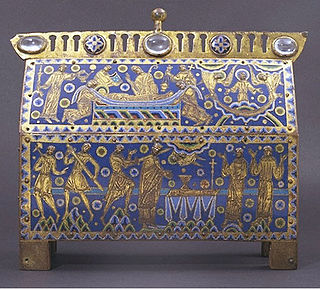 W
WThe Becket Casket is a reliquary in Limoges enamel now in the Victoria and Albert Museum. It is made of gilt-copper round a wooden core, decorated with champlevé enamel, and of a shape called a "chasse". It was made in about 1180–90 in Limoges, France, and depicts one of the most infamous events in English history. On the night of 29 December 1170, Archbishop Thomas Becket was murdered in Canterbury cathedral by four knights obeying the wishes of King Henry II. It provoked outrage throughout Europe, and pilgrims flocked to Canterbury to pray at the site of the murder. In 1173 Becket was canonized and his shrine was one of the most famous in the Christian world, until its total destruction in 1538 during the reign of Henry VIII. It is thought that this particular casket was made to hold the relics of Thomas Becket that were taken to Peterborough Abbey by Abbot Benedict in 1177. Benedict had been Prior at Canterbury Cathedral and therefore saw Becket's assassination.
 W
WThe Bernward Column also known as the Christ Column is a Romanesque bronze column, made c. 1000 for St. Michael's Church in Hildesheim, Germany, and regarded as a masterpiece of Ottonian art. It was commissioned by Bernward, thirteenth bishop of Hildesheim. It depicts images from the life of Jesus, arranged in a helix similar to Trajan's Column: it was originally topped with a cross or crucifix. During the 19th century, it was moved to a courtyard and later to Hildesheim Cathedral. During the restoration of the cathedral from 2010 to 2014, it was moved back to its original location in St. Michael's, but was returned to the Cathedral in August 2014.
 W
WThe Brunswick Lion is a medieval sculpture, created in bronze between 1164 and 1176, and the best-known landmark in the German city of Brunswick. The Brunswick Lion was originally located on the Burgplatz square in front of the Brunswick Cathedral. The monument was moved to Dankwarderode Castle in 1980, and later replaced at the original location by a replica. Within Brunswick, it is commonly known as the "Castle Lion" (Burglöwe).
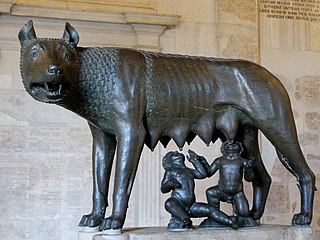 W
WThe Capitoline Wolf is a bronze sculpture depicting a scene from the legend of the founding of Rome. The sculpture shows a she-wolf suckling the mythical twin founders of Rome, Romulus and Remus. According to the legend, when King Numitor, grandfather of the twins, was overthrown by his brother Amulius in Alba Longa, the usurper ordered them to be cast into the Tiber River. They were rescued by a she-wolf that cared for them until a herdsman, Faustulus, found and raised them.
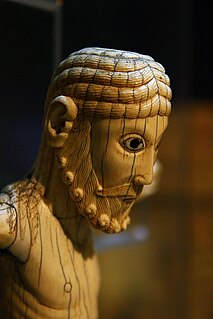 W
WThe Carrizo Christ is an 11th-century ivory carving and is conserved in the Museo de León, León (Spain). The figure is 13 inches (33 cm) high. The piece came from the Cistercian monastery of Santa María de Carrizo located some 16 miles west of León.
 W
WA chasse, châsse or box reliquary is a shape commonly used in medieval metalwork for reliquaries and other containers. To the modern eye the form resembles a house, though a tomb or church was more the intention, with an oblong base, straight sides and two sloping top faces meeting at a central ridge, often marked by a raised strip and decoration. From the sides there are therefore triangular "gable" areas.
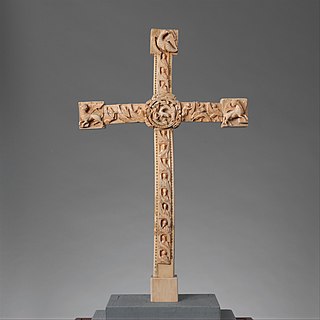 W
WThe Cloisters Cross, also referred to as the Bury St Edmunds Cross, is a complex 12th-century ivory Romanesque altar cross in The Cloisters, part of the Metropolitan Museum of Art in New York. The cross is carved from walrus ivory.
 W
WThe crucifix of Ferdinand and Sancha is an ivory carving from circa 1063, today in the National Archaeological Museum of Spain. It was part of an offering by King Ferdinand I of León and Queen Sancha to furnish the basilica of San Isidoro de León. It is the earliest known crucifix from Spain depicting the body of Christ. Although earlier Spanish crucifixes of gold, ivory and wood are known, they are all without images. The official inventory of the royal gift describes the crucifix as "a cross of ivory with the image of our crucified Redeemer". It measures 52 cm high, 34.5 cm wide, and 1 cm thick, with the width of the cross beams being 7 cm. The image of Christ is 305 mm tall.
 W
WEntry of Christ into Jerusalem is an 1125 fresco by the Master of San Baudelio de Berlanga, originally located at San Baudelio de Berlanga but now on display in the Indianapolis Museum of Art, which is in Indianapolis, Indiana. It depicts Christ and seven disciples entering Jerusalem to the acclaim of its inhabitants.
 W
WErill la Vall Descent from the Cross is a set of seven 12th-century wooden sculptures from the Pyrenees village of Erill la Vall in Catalonia, originally painted, comprising a complete Romanesque Descent from the Cross sculpture group, which in Catalonia has the peculiarity that it is made up of seven figures. Two of the carvings are kept at the National Art Museum of Catalonia (MNAC) and the rest at the Vic Episcopal Museum.
 W
WThe Gloucester Candlestick is an elaborately decorated English Romanesque gilt-bronze candlestick, now in the Victoria and Albert Museum in London. It was made for Gloucester Cathedral between 1104 and 1113, and is one of the outstanding survivals of English Romanesque metalwork.
 W
WThe Gloucester tabula set is the earliest surviving board and complete set of counters for the game tabula, a predecessor of backgammon. Dating from the 11th or early 12th century, it is an example of Romanesque art. Discovered on the site of Gloucester Castle in 1983, in the English city of Gloucester, it is now on display in the Museum of Gloucester.
 W
WThe Gniezno Doors are a pair of bronze doors placed at the entrance to Gniezno Cathedral in Gniezno, Poland. They are decorated with eighteen bas-relief scenes from the life of St. Adalbert, whose remains had been purchased for their weight in gold and brought back to, and enshrined in, the cathedral. The cathedral is a Gothic building which the doors predate, having been carried over from an earlier temple. The doors were made about 1175, in the reign of Mieszko III the Old, and are one of the most important works of Romanesque art in Poland.
 W
WThe Gospels of Henry the Lion were intended by Henry the Lion, Duke of Saxony, for the altar of the Virgin Mary in the church of St. Blaise's Abbey, Brunswick, better known as Brunswick Cathedral. The volume is considered a masterpiece of Romanesque book illumination of the 12th century.
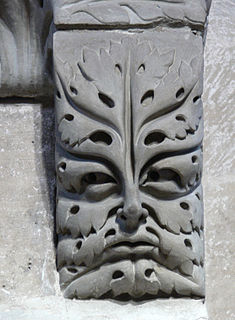 W
WThe Green Man, and very occasionally the Green Woman, is a legendary being primarily interpreted as a symbol of rebirth, representing the cycle of new growth that occurs every spring. The Green Man is most commonly depicted in a sculpture, or other representation of a face which is made of, or completely surrounded by, leaves.
 W
WThe Guelph Treasure is a collection of medieval ecclesiastical art originally housed at Brunswick Cathedral in Braunschweig, Germany. The Treasure takes its name from the princely House of Guelph of Brunswick-Lüneburg.
 W
WThe Herefordshire School is the name of a hypothetical group of master masons working in Herefordshire and Worcestershire during the 12th century. The name was coined by Polish-English scholar George Zarnecki. Their distinctive Romanesque sandstone and limestone carvings are to be found in several parish churches in the area, most notably Kilpeck, but also Eardisley, Shobdon and Castle Frome in Herefordshire, and Rock, Worcestershire. Their work draws on a variety of cultural sources for its religious and mystical images; Norman military figures, Anglo-Saxon animals and Celtic abstract patterns combine to create a unique and beautiful synthesis. Despite its overtly religious nature, Herefordshire School work also has a playful, occasionally bawdy approach.
 W
WThe Hezilo chandelier is an 11th-century Romanesque wheel chandelier. It is part of the treasures of the Hildesheim Cathedral in Hildesheim, Germany, which has been a UNESCO World Cultural Heritage site since 1985. The chandelier was most likely commissioned by Bishop Hezilo of Hildesheim, who rebuilt the cathedral after a fire. He probably also influenced the program of imagery and inscriptions. It is the largest of four extant wheel chandeliers of the period; the others surviving examples are the Azelin chandelier, the Barbarossa chandelier in the Aachen Cathedral, and the Hartwig chandelier in the Abbey of Comburg.
 W
WThis is a list of illuminated manuscripts.
 W
WThe Lewis chessmen or Uig chessmen, named after the island or the bay where they were found, are a group of distinctive 12th-century chess pieces, along with other game pieces, most of which are carved from walrus ivory. Discovered in 1831 on Lewis in the Outer Hebrides of Scotland, they may constitute some of the few complete, surviving medieval chess sets, although it is not clear if a set as originally made can be assembled from the pieces. When found, the hoard contained 93 artifacts: 78 chess pieces, 14 tablemen and one belt buckle. Today, 82 pieces are owned and usually exhibited by the British Museum in London, and the remaining 11 are at the National Museum of Scotland in Edinburgh.
 W
WThe ninety-three game pieces of the Lewis chessmen hoard were found on the Isle of Lewis in the Outer Hebrides of Scotland. Medieval in origin, they were first exhibited in Edinburgh in 1831 but it is unclear how much earlier they had been discovered. The hoard comprised seventy-eight distinctive chess pieces and fifteen other non-chess pieces, nearly all carved from walrus tusk ivory, and they are now displayed at the British Museum in London and National Museums Scotland in Edinburgh. Another chess piece, which turned up in 1964 and in 2019 was attributed to have come from the original hoard, now belongs to an undisclosed owner.
 W
WThe Lucchese School, also known as the School of Lucca and as the Pisan-Lucchese School, was a school of painting and sculpture that flourished in the 11th and 12th centuries in Pisa and Lucca in Tuscany with affinities to painters in Volterra. The art is mostly anonymous. Although not as elegant or delicate as the Florentine School, Lucchese works are remarkable for their monumentality.
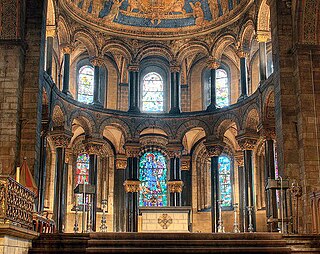 W
WMosan art is a regional style of art from the valley of the Meuse in present-day Belgium, the Netherlands, and Germany. Although in a broader sense the term applies to art from this region from all periods, it generally refers to Romanesque art, with Mosan Romanesque architecture, stone carving, metalwork, enamelling and manuscript illumination reaching a high level of development during the 11th, 12th and 13th centuries.
 W
WThe paintings from Arlanza are a set of frescos belonging to the mural decoration of a Benedictine monastery of San Pedro de Arlanza, in the Province of Burgos, Castile and León, Spain, dating to around 1210, and now dispersed among a number of collections. The Spanish government began to detach and sell sections of the frescos in the 19th century, though less exciting sections remain in situ. In 1943, the largest group of six major fragments was moved to the National Art Museum of Catalonia of Barcelona. Most of the Romanesque mural painting that has survived is of religious subjects. There was also fine decorations of a courtly or profane nature in large monastic centres, such as Arlanza in Castile, and these fragments represent especially rare survivals. According to C. R. Dodwell, the "imposing" Arlanza paintings are "endowed with all the power and grandeur of Romanesque at its best".
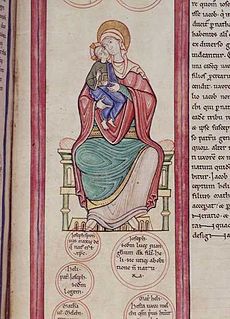 W
WThe Parc Abbey Bible is a 12th-century illuminated Bible. It was made in the Leuven region of Belgium at the Abbey of St. Mary of Parc. A colophon on folio 197 indicates that the codex was produced in 1148. The text is Latin and written in proto-gothic book script on vellum. The folios are 437 by 300 mm, with the text block being 340 by 240 mm. The manuscript is illuminated with miniatures, diagrams, decorated borders, and decorated initials. The decorated initials include historiated, inhabited, and foliate initials.
 W
WThe Portico of Glory of Santiago de Compostela Cathedral is a Romanesque portico and the cathedral's main gate created by Master Mateo and his workshop, on the orders of King Ferdinand II of León. The king donated to Mateo one hundred maravedís annually between 1168 and 1188. To commemorate its completion in 1188, the date was carved on a stone set in the cathedral and on the lintel that supports the richly ornamental tympanum. Under the contract made in 1168, if Mateo was to renege on the deal to create the portico at any time, he would have to pay 1,000 gold pieces (aureos). The complete three-piece set took until 1211 to completely finish; when the cathedral was consecrated in the presence of King Alfonso IX of León.
 W
WThe Romanesque style of architecture was introduced in Portugal between the end of the 11th and the beginning of the 12th century. In general, Portuguese cathedrals have a heavy, fortress-like appearance, with crenellations and few decorative elements apart from portals and windows. Portuguese Romanesque cathedrals were later extensively modified, among others the Old Cathedral of Coimbra, although it only had some minor changes.
 W
WRomanesque is the architecture of Europe which emerged in the late 10th century and evolved into Gothic architecture during the 12th century. The Romanesque style in England is more traditionally referred to as Norman architecture.
 W
WThe Iglesia de San Román is a church in Toledo. The church was built in the Mudéjar style in the 13th century. On this site there was an old Visigothic structure and probably an ancient Roman building.
 W
WThe Shrine of the Three Kings, Tomb of the Three Kings, or Tomb of the Three Magi is a reliquary traditionally believed to contain the bones of the Biblical Magi, also known as the Three Kings or the Three Wise Men. The shrine is a large gilded and decorated triple sarcophagus placed above and behind the high altar of Cologne Cathedral in western Germany. Built approximately from 1180 to 1225, it is considered the high point of Mosan art and the largest reliquary in the Western world.
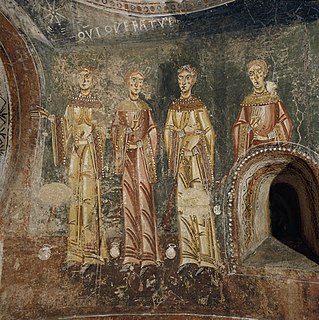 W
WThe Southern apse from Pedret is a fresco painting which was acquired during the 1919-1923 campaign of the Junta de Museus. The artwork originated from the southern apsidiole of the Church of Sant Quirze de Pedret and is currently exhibited in the Romanesque Art collection at the Museu Nacional d’Art de Catalunya, Barcelona, Spain.
 W
WSpanish Romanesque designates the Romanesque art developed in the Hispanic-Christian kingdoms of the Iberian Peninsula in the 11th and 12th centuries. Its stylistic features are essentially common to the European Romanesque although it developed particular characteristics in the different regions of the peninsula. There is no Romanesque art in the southern half of the peninsula because it remained under Muslim rule (Al-Andalus). The examples of Romanesque buildings in the central area of the peninsula are sparse and of the latest period, with virtually no presence south of the Ebro and the Tagus. Most Romanesque buildings can be found in the northern third of the peninsula. Romanesque art was introduced into the peninsula from east to west, so scholars have usually defined regional characteristics accordingly: the "eastern kingdoms" comprising the Pyrenean areas, Catalan Romanesque, Aragonese Romanesque and Navarrese Romanesque, and the "western kingdoms" comprising Castilian-Leonese Romanesque, Asturian Romanesque, Galician Romanesque and Portuguese Romanesque.
 W
WThe Tapestry of Creation or Girona Tapestry is a Romanesque panel of needlework from the 11th century, housed in the Museum of the Cathedral of Girona, Catalonia, Spain. Measuring 3.65 m × 4.70 m, it originally may have served as a baldachin for the Altar of the Holy Cross in the church's entrance. Some believe that it was used as a curtain or even a carpet. It depicts a series of theological scenes related with the Christian creation myths.
 W
WThe three hares is a circular motif or meme appearing in sacred sites from the Middle and Far East to the churches of Devon, England, and historical synagogues in Europe. It is used as an architectural ornament, a religious symbol, and in other modern works of art or a logo for adornment, jewelry, and a coat of arms on an escutcheon. It is viewed as a puzzle, a topology problem or a visual challenge, and has been rendered as sculpture, drawing, and painting.
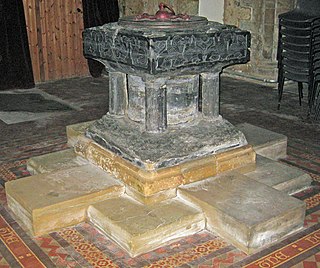 W
WTournai fonts are a type of baptismal font made from blue black limestone during the 12th and early 13th centuries in and around the Belgian town of Tournai by local masons. There are seven complete examples in England and a disputed number in Europe: eighty according to one source, or fifty in Northern France and Belgium and two in Germany according to another.
 W
WA triptych is a work of art that is divided into three sections, or three carved panels that are hinged together and can be folded shut or displayed open. It is therefore a type of polyptych, the term for all multi-panel works. The middle panel is typically the largest and it is flanked by two smaller related works, although there are triptychs of equal-sized panels. The form can also be used for pendant jewelry.
 W
WThe triquetra is a triangular figure composed of three interlaced arcs, or (equivalently) three overlapping vesicae piscis lens shapes.
 W
WThe Viklau Madonna is a late 12th-century wooden Madonna, probably made on Gotland in present-day Sweden. The statuette is one of the best-preserved 12th-century wooden statuettes from Europe. Named after the medieval Viklau Church where it was originally located, it was bought by the Swedish History Museum in 1928 and is today in the museum in Stockholm. In 2017, it was discovered that a relic had been placed inside the statuette. The statuette depicts Mary, wearing gilded clothes and a golden crown, sitting on a tall chair. Originally, the Madonna was depicted holding the infant Christ in her arms, but this part of the sculpture has been lost.
 W
WA wheel chandelier is a lighting installment, in the form of a chandelier hanging from the ceiling in the form of a spoked wheel. The oldest and most important examples derive from the Romanesque period.